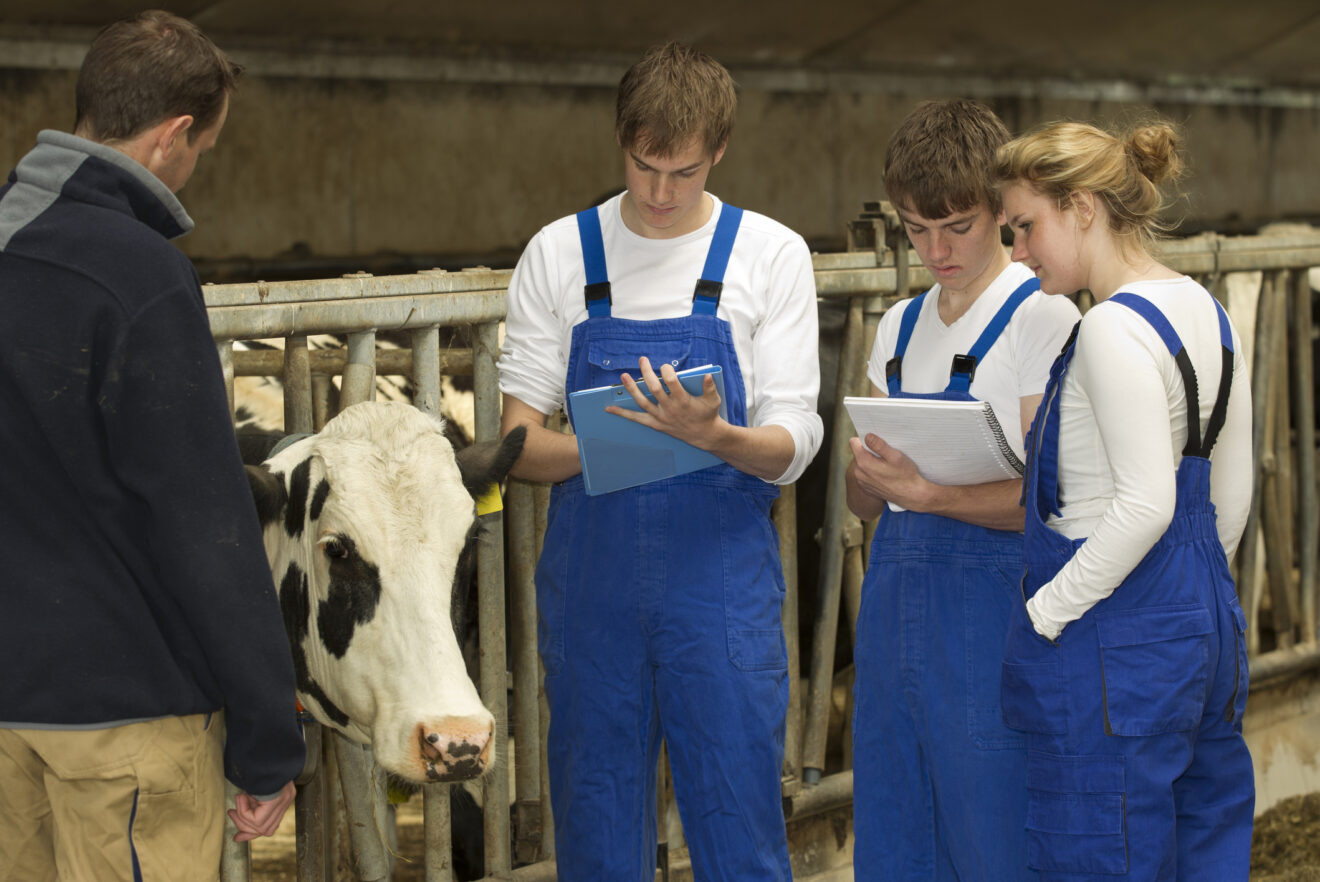Purposeful and meaningful work is important to all of us. It provides a sense of belonging and connection. All K-12 education prepares students to contribute to their communities through work, but in a career and technical education program or school, we work toward that goal more explicitly. Here, internships and other work-based educational opportunities are important for providing students the opportunity to progress to competence.

Teachers can provide students with all the conceptual knowledge there is, but a work-based experience puts that conceptual knowledge into context in a way that’s not possible in the classroom. Being in a veterinarian’s office, for example, a student will learn from real cases, take direction from professionals, see them taking in information verbally or textually to make decisions, and manage a team to meet a goal. That leads to questioning why they held certain misconceptions about the job and what all these new experiences mean. By discussing those kinds of metacognitive questions with a mentor, they begin to develop new skill sets.
This becomes a cycle. As students gain more conceptual knowledge and skills, they have more opportunities to perform work relevant to the industry they are interested in joining, which leads to more understanding and self-reflection. Whether these skills are transferable, like the ability to collaborate, or something specific and technical, like assisting with anesthetizing a dog, students are learning skills that are actually relevant to the workforce.
From the 2021-22 school year to the 2022-23 school year, Ulster Board of Cooperative Educational Services in New York raised our placements in work-based learning opportunities from a few dozen to more than 200. Here’s how we did it and how we plan to continue improving until every one of our students has the opportunity to learn on the job.
Challenges of work-based opportunities
Providing students work-based opportunities is not easy. As educators, we sometimes have the tendency to think of students as empty vessels that need to be filled with knowledge. That can lead to the idea that students aren’t ready to turn a wrench or otherwise experience the sensory and hands-on pieces of skilled trades because there is always more knowledge to pour into those vessels. With the right mentors, however, students don’t need to be experts to participate in work and to learn what it feels like to get the job done.
Other challenges of work-based opportunities take more than a change of perspective. In a rural district, such as the ones we serve, it can be difficult to find enough mentors and internships nearby to service the specific trade areas we offer students.
When there is alignment between our programs and potential local mentors, it can be difficult to build the necessary relationships. Those would-be mentors may wonder if bringing a student in is worth it. Even if the mentors are willing, coming to an agreement about what constitutes a high-quality, work-based experience and an agreed-upon list of employability skills can be a challenge. To accomplish this, we engage a steering committee of experts in the relevant field, ask them what they want in future employees and use that information to build projects that relate to those skill sets.
Even when all of that works out for us, it’s still difficult to find people who understand that internships are not transactional. It’s not going to be a dollar-for-dollar or hour-for-hour exchange between their company and our students. It’s an investment in their future workforce.
Helping students get their hands dirty
Our workplace coordinator, Steve Casa, had amazing success increasing placements year over year from a few dozen to more than 200 in the last school year. He did it by engaging employers; ensuring there was access to expert mentors, challenges or work that needed to be done; and partners who were willing to invest their time and resources into young people looking to grow in their industry. He stayed connected with them, brought them together frequently for discussions and was clear about the employability skills we had already provided and the expectations we had of them as partners.
Showing potential partners your victories is also helpful in bringing them on board. We had students collectively earning $11,000 each week from work-based experiences. Whether anecdotally or through data, we were able to make potential partners feel much more comfortable by showing them all the successful partnerships we already had. When your mentors start recruiting new mentors for you, finding new partners becomes a little easier.
Once a relationship is built, we can ask our business community for challenges to serve as the launch point for a project or learning experience. Our teachers then facilitate students as they work to design a response to the challenge. Throughout the process, the industry partner will provide true technical feedback. At the end, the student will reflect and make a presentation about their learning along the way.
The goal with each of our partners is to systematize that process. Perhaps at first they take a single student and learn that it’s rewarding to work with these students. At the next opportunity, they take on two or three students. Eventually, we hope it becomes an institutional relationship that’s protocol-based because they know how students will contribute. No matter who is running the program at Ulster, the partners will take a few students each term because it’s part of their company culture.
Expanding work-based opportunities
We have a rubric that’s called an employability profile. Mentors fill it out to give students feedback on how they are performing as employees relative to the industry they’re working in. It takes time for our workplace coordinator to teach someone how to fill it out, so to keep growing our work-based learning opportunities, we need more people.
We have five clusters of trade groups, and eventually we plan to have a workplace coordinator for each of them. We also have eight component districts with students who don’t participate in our CTE offerings. They also deserve work-based learning opportunities, so we plan to bring on another workplace coordinator for each of those districts. To streamline the process for our industry partners, all of these coordinators will be on the same team. Below each workplace coordinator, we plan to bring in job coaches, whose responsibilities will include outreach and engagement with students, their families and the industry partner they are working with.
We are also looking to expand on an opportunity-by-opportunity basis. After COVID, a principal from one of our component districts told us we had to stop charging students for the equipment necessary to participate in CTE programs. In New York, requiring students to pay for anything required by the syllabus or curriculum is illegal — but more importantly, charging students isn’t equitable.
We stopped charging students to participate, which meant that we had to show how we valued the opportunities we provide by honoring them in our budget. That, in turn, led us to start asking of each opportunity, “How do we expand this? How do we make this accessible to more students?”
If it’s a field trip, for example, we begin by asking who else could benefit besides the students already attending. Since it’s coming out of our budget, now we want to be certain that the students will hear from an expert and have an experience that they would not otherwise have had. And lately, we’ve also been asking if students can receive some kind of challenge while they are there. Will the industry representatives involved stay connected in some way? Will they make themselves available to students through the end of the challenge to help them debrief and reflect on their experiences and learning as they worked on it?
Paying it forward
When I was in seventh grade, I had a health teacher who impacted the entire school every day because she took these kinds of chances. At one point, she decided that she wanted our community to become a Tree City USA. She had to teach us a recycling curriculum that took us out to recycling centers, and she had to teach us to become advocates. She connected with a nongovernmental organization at the UN and took a gaggle of seventh graders to the UN four times that year, where we presented to expert adults who took us seriously and provided honest feedback.
Then she took us to Montreal for four days, where we stayed in a hotel, sang French songs, ate new food and planted trees around Quebec. Not all work-based learning experiences need to involve that much travel, but that experience helped me grow — from becoming a teacher in the 1990s who believed every kid should have a library card to becoming a CTE principal in the 2020s who believes that every kid should have a passport.
The experiential learning that teacher gave me in seventh grade taught me what it was like to learn, become trusted and work with a team to accomplish a goal. All students deserve as much.
Peter Harris is the assistant superintendent of career and technical education and alternative education (HVPA and Phoenix Academy). He can be reached at [email protected].
Opinions expressed by SmartBrief contributors are their own.
_________________________
Subscribe to SmartBrief’s FREE email ASCD newsletter to see the latest hot topics in education. It’s among SmartBrief’s more than 250 industry-focused newsletters.
